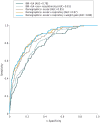Predictors for the development of referral-warranted retinopathy of prematurity in the telemedicine approaches to evaluating acute-phase retinopathy of prematurity (e-ROP) study
- PMID: 25521746
- PMCID: PMC4416963
- DOI: 10.1001/jamaophthalmol.2014.5185
Predictors for the development of referral-warranted retinopathy of prematurity in the telemedicine approaches to evaluating acute-phase retinopathy of prematurity (e-ROP) study
Abstract
Importance: Detection of treatment-requiring retinopathy of prematurity (ROP) involves serial eye examinations. An ROP prediction model using predictive factors could identify high-risk infants and reduce required eye examinations.
Objective: To determine predictive factors for the development of referral-warranted (RW) ROP.
Design, setting, and participants: This multicenter observational cohort study included secondary analysis of data from the Telemedicine Approaches to Evaluating Acute-Phase Retinopathy of Prematurity Study. Infants included in the study had a birth weight (BW) of less than 1251 g.
Exposures: Serial ROP examinations of premature infants who had 2 or more ROP examinations.
Main outcomes and measures: Incidence of RW-ROP (defined as the presence of plus disease, zone I ROP, or ROP stage 3 or greater in either eye) and associations with predictive factors.
Results: Among 979 infants without RW-ROP at first study-related eye examination (median postmenstrual age, 33 weeks; range, 29-40 weeks) who underwent at least 2 eye examinations, 149 (15.2%) developed RW-ROP. In a multivariate model, significant predictors for RW-ROP were male sex (odds ratio [OR], 1.80; 95% CI, 1.13-2.86 vs female), nonblack race (OR, 2.76; 95% CI, 1.50-5.08 for white vs black race and OR, 4.81; 95% CI, 2.19-10.6 for other vs black race), low BW (OR, 5.16; 95% CI, 1.12-7.20 for ≤500 g vs >1100 g), younger gestational age (OR, 9.79; 95% CI, 3.49-27.5 for ≤24 weeks vs ≥28 weeks), number of quadrants with preplus disease (OR, 7.12; 95% CI, 2.53-20.1 for 1-2 quadrants and OR, 18.4; 95% CI, 4.28-79.4 for 3-4 quadrants vs no preplus disease), stage 2 ROP (OR, 4.13; 95% CI, 2.13-8.00 vs no ROP), the presence of retinal hemorrhage (OR, 4.36; 95% CI, 1.57-12.1 vs absence), the need for respiratory support (OR, 4.99; 95% CI, 1.89-13.2 for the need for controlled mechanical ventilator; OR, 11.0; 95% CI, 2.26-53.8 for the need for high-frequency oscillatory ventilation vs no respiratory support), and slow weight gain (OR, 2.44; 95% CI, 1.22-4.89 for weight gain ≤12 g/d vs >18 g/d). These characteristics predicted the development of RW-ROP significantly better than BW and gestational age (area under receiver operating characteristic curve, 0.88 vs 0.78; P < .001).
Conclusions and relevance: When controlling for very low BW and prematurity, the presence of preplus disease, stage 2 ROP, retinal hemorrhage, and the need for ventilation at time of first study-related eye examination were strong independent predictors for RW-ROP. These predictors may help identify infants in need of timely eye examinations.
Conflict of interest statement
Figures


Comment in
-
Predictors for referral-warranted retinopathy of prematurity.Acta Paediatr. 2017 Jun;106(6):1013. doi: 10.1111/apa.13740. Epub 2017 Jan 30. Acta Paediatr. 2017. PMID: 28134457 No abstract available.
References
-
- Gilbert C. Retinopathy of prematurity: a global perspective of the epidemics, population of babies at risk and implications for control. Early Hum Dev. 2008;84(2):77–82. - PubMed
-
- Cryotherapy for Retinopathy of Prematurity Cooperative Group. Multicenter trial of cryotherapy for retinopathy of prematurity: preliminary results. Arch Ophthalmol. 1988;106(4):471–479. - PubMed
-
- Good WV, Hardy RJ Early Treatment for Retinopathy of Prematurity Cooperative Group. The multicenter study of Early Treatment for Retinopathy of Prematurity (ETROP) Ophthalmology. 2001;108(6):1013–1014. - PubMed
-
- Early Treatment for Retinopathy of Prematurity Cooperative Group. Revised indications for the treatment of retinopathy of prematurity: results of the Early Treatment for Retinopathy of Prematurity Randomized Trial. Arch Ophthalmol. 2003;121(12):1684–1694. - PubMed
Publication types
MeSH terms
Grants and funding
LinkOut - more resources
Full Text Sources
Other Literature Sources
Medical

